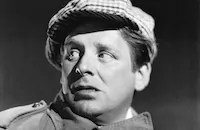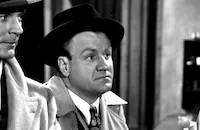T-Men

Brief Synopsis
Cast & Crew
Anthony Mann
Dennis O'keefe
Mary Meade
Alfred Ryder
Wally Ford
June Lockhart
Film Details
Technical Specs

Synopsis
In Los Angeles, an informant who has promised to turn over a sample of the paper being used by a counterfeiting ring to a U.S. Treasury agent is killed. Later, in Washington, Treasury Department chief Carson assigns Dennis O'Brien and Anthony Genaro to infiltrate the gang through connections in Detroit. O'Brien and Genaro assume the names Vannie Harrigan and Tony Galvani, respectively, and create personal background histories to support their new identities. After the Detroit police cooperate by identifying them as robbery suspects, the agents contact with local crime boss Carlo Vantucci, who runs a produce market as a front. Vantucci checks them out and hires them to work in his counterfeit liquor stamps racket, where they soon discover the name of the mob's Los Angeles connection, The Schemer. After Dennis leaves for Los Angeles, Vantucci roughs up Tony, but Tony covers for his fellow agent. A long, laborious search through Los Angeles pays off when Dennis locates The Schemer in a bath house. Dennis then contacts local Treasury chief Gregg, who supplies him with some counterfeit bank notes, and follows The Schemer to a hotel, where they both become involved in an illegal dice game. Dennis passes a counterfeit bill, which The Schemer immediately recognizes and offers to supply him with better paper if he will provide the engraving plates. After Dennis follows The Schemer to the Club Trinidad near Pacific Ocean Park, The Schemer makes contact with a club photographer, who takes the phony bill to her boss, Paul Miller, at a photo lab. When The Schemer finds out that Dennis has been following him, he has him mugged by two of his men, Moxie and Brownie, who later take him to The Schemer's boss, Shiv Triano. As they play pool, Dennis suggests a partnership to Triano. Later, Triano checks out Dennis with Vantucci, who also sends Tony to Los Angeles. Dennis sends a sample of the paper to the Treasury Department's lab in Washington and learns that it may have been made in China. After Dennis delivers one of the engraving plates, to Triano, he makes a deal to deliver the other when he meets Triano's boss, the mastermind of the whole organization. Dennis and Tony then try to set up The Schemer, who reveals to them that he has written down, in code, all the activities of the local "Mr. Big." While Tony and The Schemer are shopping at the Farmer's Market, Tony is recognized by a friend of his wife, Mary, who is accompanying her on a visit from San Francisco. Mary, suddenly realizing that she must not reveal their relationship and identity in front of a stranger, declares to her friend that she is mistaken about Tony being her husband and leaves. The boss, meanwhile, has arrived on a ship from China and Dennis meets with his second-in-command, Diana Simpson. Lacking confidence in The Schemer, Diana orders Moxie to eliminate him, but before Moxie kills him in a steam bath, The Schemer tells him that Tony has been trying to make phone calls to San Francisco. After Triano has his people in San Francisco check on Mary, he tells Dennis that his friend is a Treasury agent. Just as Tony locates The Schemer's notebook, Triano shoots him in front of Dennis and Tony dies without implicating him. Los Angeles agents then gain possession of the notebook, and the simple code is broken, revealing details of profits from gambling, liquor and counterfeiting activities. Dennis is warned that the Department has discovered that Miller, the gang's engraver, can identify the source of the face plate as he worked with the man who made it. Dennis is advised to abandon the case but persists, and although the boss rejects the plate for some reason, Dennis insists that they bring Miller to the tanker. There Miller claims not to recognize the plate but privately tells Dennis that he does, then realizes that Dennis is a Treasury agent and offers to turn government witness. However, their talk is overheard by Moxie, who kills Miller. Dennis takes Miller's gun and, after a chase during which he is wounded, kills Moxie. The police arrive in force and swarm over the ship, finally arresting the ringleader, whose associates in Detroit and Shanghai are also picked up. Dennis recovers and Mary Genaro carries in her heart the memory of her husband who died in the service of his country.

Director

Anthony Mann
Cast

Dennis O'keefe
Mary Meade
Alfred Ryder

Wally Ford
June Lockhart

Charles Mcgraw

Jane Randolph
Art Smith
Herbert Heyes
Jack Overman
John Wengraf
Jim Bannon
William Malten

Vivian Austin
James Seay
John Newland

Tito Vuolo
John Parrish

Lyle Latell
Curt Conway
Ricki Van Dusen
Irmgard Dawson
Robert Williams
Anton Kosta
Paul Fierro
Louis Bacigalupi
Trevor Bardette
William Yip
Al Bridge

Keefe Brasselle
Jerry Jerome
Bernie Sell
Ralph Brooks
John Ardell
Cuca Martinez
Salvadore Barroga

Frank Ferguson
Cecil Weston
George Carleton
Gayne Whitman
Les Sketchley
George M. Manning
Victor Cutler
Sandra Gould
Tom Mcguire
Mira Mckinney
Frank Hyers
Crew
Fred Allen
John Alton
Alma Armstrong
Leon Becker
Emil Cadkin
Alfred De Gaetano
France Ehren
Bryan Foy
Irving Friedman
John C. Higgins
Elmer Lincoln Irey
Edward C. Jewell
Virginia Kellogg
Howard W. Koch
Armor Marlowe
Frank Mcwhorter
Jack R. Rabin
Paul Sawtell
Aubrey Schenck
Turner Shelton
Edward Small
Joan St. Oegger
Stewart Stern
Joe Stinton
George J. Teague
Ern Westmore

Photo Collections
Videos
Movie Clip




Hosted Intro
Film Details
Technical Specs

Award Nominations
Best Sound
Articles
T-Men
The story, which is really just an excuse for Mann to tighten the screws on a bunch of characters, features square-jawed Dennis O'Keefe as a treasury agent who's determined to break up a counterfeiting ring. O'Keefe and his partner (Alfred Ryder), are forced to go undercover to infiltrate the Detroit mob and things get increasingly intense as the story progresses; a couple of murderous set-pieces are as shocking today as they were 50 years ago.
T-Men, arguably the strongest picture from Mann's noir period, boasts a raw documentary feel that will remind some viewers of the classic TV series, Dragnet. But Mann's brilliant cinematographer, George Alton, gives the film a memorably stark look. Add a first-rate script by John C. Higgins, and Mann's almost intuitive command of the visual language of cinema, and T-Men is a surprisingly powerful B-picture, an urban crime drama for the ages.
As always, Mann's sure sense of visual flair is virtually undetectable. Even in the stylized noir tradition, there's a naturalism to his storytelling, an emotional honesty that serves as the backbone of his work. Mann always generates steam while appearing to never break a sweat.
Astonishing events occur in Mann's films, but they're seldom introduced with the tacky flourishes that we've come to expect from commercial melodrama, especially during the period when Mann was making his most widely-praised films. Fans of T-Men often cite a sequence during which an unlucky character is killed in a steam bath as one of the classics of film noir, and it's managed with remarkable economy. Mann obviously knew that this type of film requires a first-rate photographer, so it's no surprise that he later teamed up with Alton on two more classic noir exercises, Raw Deal (1948) and Reign of Terror (1949).
It makes sense that Mann regularly pulled quality performances from his actors- after all, he began his career as a stage performer. During the 1920s, he actually had a few featured roles on Broadway. Eventually, after serving time as both a stage manager and set designer, he decided that he wanted to direct. The first time he ever got behind a camera was when David O. Selznick, who was impressed with the range of Mann's success on Broadway, hired the fledgling auteur to supervise screen tests for Gone With the Wind (1939), Intermezzo (1939), and Rebecca (1940). Mann then became an assistant to Preston Sturges on Sullivan's Travels (1941), where he surely learned a thing or two about making movies.
Producer: Aubrey Schenck Director: Anthony Mann
Screenplay: John C. Higgins (based on a story by Virginia Kellogg)
Cinematography: John Alton
Music: Paul Sawtell
Editor: Fred Allen
Art Designer: Edward C. Jewell
Special Effects: George J. Teague
Set Designer: Armor Marlowe
Costumes: Frances Ehren
Makeup: Ern Westmore, Joe Stinton Cast: Dennis O'Keefe (Dennis O'Brien), Alfred Ryder (Tony Genaro), Mary Meade (Evangeline), Wallace Ford (Schemer), June Lockhart (Tony's wife), Charles McGraw (Moxie), Jane Randolph (Diana), Art Smith (Gregg), Herbert Heyes (Chief Carson), Jack Overman (Brownie), John Wengraf (Shiv).
B&W-92m.
by Paul Tatara

T-Men
Quotes
Trivia
Notes
The film's working title was T-Man. The following title appears after Anthony Mann's credit: "The United States currency and the credentials of the Treasury Department shown in this film were photographed by special permission of the Secretary of the Treasury. Further reproduction of said currency or credentials in whole or part is strictly prohibited." The film is then introduced by Elmer Lincoln Irey, the retired chief coordinator of the Treasury Department's police units. According to an October 1947 New York Times article, T-Men was the first film to be based on actual Treasury Dept. Law Enforcement files.
Associate producer Turner B. Shelton was a former aide in the Treasury Dept., according to Hollywood Reporter. The Hollywood Reporter also reported that the film was shot mostly on location in Detroit, New York, Washington, Boston, San Pedro and Wilmington (CA). A pre-production Los Angeles Times news item claimed that the original story had been written by Henry Blankfort, not credited writer Virgina Kellogg. In February 1948, Life Magazine reported that the film had been made for a "slim $450,000." T-Men received an Academy Award nomination for Best Sound Recording. A radio adaptation of the film was broadcast on Lux Radio Theatre on February 23, 1948 and starred Dennis O'Keefe and Gail Patrick.

Miscellaneous Notes
Released in United States 1983
Released in United States November 1971
Released in United States Winter January 10, 1948
Released in United States 1983 (Shown at FILMEX: Los Angeles International Film Exposition (A "B-Movie" Marathon) April 13 - May 1, 1983.)
Released in United States Winter January 10, 1948
Released in United States November 1971 (Shown at FILMEX: Los Angeles International Film Exposition (The Film Noir) November 4-14, 1971.)















